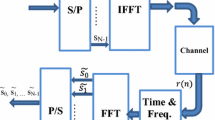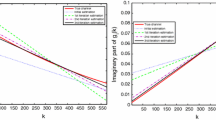Abstract
This paper deals with the problem of non data aided (NDA) signal to noise ratio (SNR) estimation of OFDM signals transmitted through unknown multipath fading channel. Most of present day’s SNR estimators are based on the knowledge of pilot sequences which is not applicable in some contexts such as cognitive radio for example. Moreover in Multipath fading channels SNR also depends on frequency offset which is caused by mismatch between the oscillator in the transmitter and that in the receiver. Previous NDA SNR estimation schemes assumed a perfect synchronization at reception (i.e. τ = 0 and \({\varepsilon = 0}\)) which results estimation of SNR with less accuracy. The frequency offset attenuates the desired signal and causes intercarrier interference, thus reducing the SNR. In this paper we propose a new NDA SNR estimator which uses periodic redundancy induced by the cyclic prefix, considering SNR degradation due to frequency offset (\({\varepsilon}\)).
Similar content being viewed by others
Abbreviations
- N :
-
Number of subcarriers
- E s :
-
Signal power
- a k :
-
Transmitted data symbols
- D :
-
CP length
- L :
-
Rayleigh fading channel impulse response
- \({\varepsilon}\) :
-
Carrier frequency offset
- \({\vartheta}\) :
-
Initial arbitrary carrier phase
- τ :
-
Timing offset
- η(m):
-
Additive white Gaussian noise
- S c (K):
-
Inter carrier interference (ICI) coefficients
- S :
-
Signal power
- \({\mathop \sigma \nolimits_n^2}\) :
-
Noise variance
- M :
-
Number of OFDM symbols in the observation window
- \({\xi(u)}\) :
-
A random variable which follows a chi square distribution
- α :
-
Cycle frequency
- δ(.):
-
Kronecker symbol
- N c :
-
The number of considered cycle frequencies to estimate the signal power
- B c :
-
Coherence bandwidth
- \({^{\beta}}\) :
-
Coefficient expressing the desired correlation rate
- H[κ] :
-
Channel gain
- SNR0 :
-
Average SNR in the absence of a carrier frequency offset
References
Cui T., Tellambura C. (2006) Power delay profile and noise variance estimation for OFDM. IEEE Communication Letters 10: 1
Socheleau F.-X., Aïssa-El-Bey A., Houcke S. (2008) Non data-aided SNR estimation of OFDM signals. IEEE Communication letters 12: 11
Lee J., Lou H.-L., Toumpakaris I., Cioffi J. M. (2006) SNR analysis of OFDM systems in the presence of carrier frequency offset for fading channels. IEEE Communication letters 5: 12
Jallon, P. (2008). An algorithm for detection of DVB-T signals based on their second order statistics. EURASIP Journal on Wireless Communications and Networking, 2008(article ID 538236).
Gardner W. A., Napolitano A., Paurac L. (2006) Cyclostationarity: Half a century of research. Signal Processing 86(4): 639–697
Rappaport T. (2002) Wireless communications: Principles and practices. Prentice Hall, New Jersey
Moose P. H. (1994) A technique for orthogonal frequency division multiplexing frequency offset correction. IEEE Transactions on Communications 42: 2908–2914
Pollet T., Bladel M. V., Moeneclaey M. (1995) BER sensitivity of OFDM systems to carrier frequency offset and wiener phase noise. IEEE Transactions on Communications 43(2/3/4): 191–193
Daffara, F., & Chouly, A. (1993). Maximum likelihood frequency detectors for orthogonal and multicarrier systems. In Proceedings of 1993 IEEE international conference on communications (pp. 766–771).
Lashkarian N., Kiaei S. (2000) Class of cycle-based estimator for frequency offset estimation of OFDM systems. IEEE Transactions on Communications 48(12): 2139–2149
Luise M., Reggiannini R. (1996) Carrier frequency acquisition and tracking for OFDM system. IEEE Transactions on Communications 44(11): 1590–1598
Moose P. H. (1994) A technique for orthogonal frequency division multiplexing frequency offset correction. IEEE Transactions on Communications 42(10): 2908–2914
Schmidl T. M., Cox D. C. (1997) Robust frequency and timing synchronization for OFDM. IEEE Transactions on Communications 45(12): 1613–1621
Tureli U., Liu H., Zoltowski M. D. (2000) OFDM blind carrier offset estimation: ESPRIT. IEEE Transactions on Communications 48(9): 1459–1461
Vande Beek J. J., Sandell M., Borjesson P. O. (1997) ML estimation of time and frequency offset in OFDM systems. IEEE Transactions on Signal Processing 45(4): 1800–1805
Xu, H., Wei, G., & Zhu, J. (2005). A novel SNR estimation algorithm for OFDM. In Proceedings of IEEE vehicular technology conference (Vol. 5, pp. 3068–3071).
Yi, W., Lihua, L., Ping, Z., Zemin, L., & Yu, Z. (2007). A new noise variance estimation algorithm for multiuser OFDM systems. In Proceedings of IEEE conference on personal, indoor and mobile radio communications (pp. 1–4).
Park, B., Ko, E., Cheon, H., Kang, C., & Hong, D. (2001). A blind OFDM synchronization algorithm based on cyclic correlation. In Proceedings of IEEE global telecommunications conference (Vol. 5, pp. 3116–3119).
Nikookar, H., & Prasad, R. (1996). On the sensitivity of multicarrier transmission over multipath channels to phase noise and frequency offsets. In Proceedings of IEEE PIMRC ’96 (pp. 68–72).
Hwang W., Kang H., Kim K. (2003) Approximation of SNR degradation due to carrier frequency offset for OFDM in shadowed multipath channels. IEEE Communication Letters 7: 581–583
Sathananthan K., Tellambura C. (2001) Probability of error calculation of OFDM systems with frequency offset. IEEE Transactions on Communications 49: 1884–1888
Ma, X., Kobayashi, H., & Schwartz S. C. (2003). Effect of frequency offset on BER of OFDM and single carrier systems. In Proceedings of IEEE PIMRC (pp. 2239–2243).
Bingham J. A. C. (1990) Multicarrier modulation for data transmission: An idea whose time has come. IEEE Communications Magazine 28: 5–14
Le K. N. (2010) BER of OFDM in Rayleigh fading environments with selective diversity. Wireless Communications and Mobile Computing 10(2): 306–311
Le K. N., Dabke K. P. (2010) BER of OFDM with diversity and pulse shaping in Rayleigh fading environments. Digital Signal Processing 20(6): 1687–1696
Le K. N. (2008) Bounds on inter-carrier interference power of OFDM in a Gaussian scattering channel. Wireless Personal Communications 47(3): 355–362
Seshadri Sastry K., PrasadBabu M. S. (2010) Fuzzy logic based adaptive modulation using non data aided SNR estimation for OFDM system. International Journal of Engineering Science and Technology 2(6): 2384–2392
Seshadri Sastry, K., & Prasad Babu, M. S. (2010). SNR estimation for QAM signals using fuzzy logic interface. In Proceedings of IEEE ICCSIT 2010 (pp. 413–416).
Seshadri Sastry, K., & Prasad Babu, M. S. (2010). Custom modulation scheme for enhanced voice quality in software defined radio. In Proceedings of IEEE ICSESS 2010, Beijing, China.
Zolghadr Asli A. R., Masnadi Shirazi M. A., Amin Shah B., Ghamat M. H. (2006) Comparision of some methods including use of coding for reduction of ICI in OFDM channels. Iranian Journal of Information Science and Technology 4(2): 1–14
Wang, X. & Poor, H. W. Wireless Communication Systems, ISBN: 0137020805.
Tong, L., & Perreau, S. (1998). Multichannel blind channel estimation: From subspace to maximum likelihood methods. IEEE Proceedings, 1998, 1951–1968.
Author information
Authors and Affiliations
Corresponding author
Rights and permissions
About this article
Cite this article
Sastry, K.S., Prasad Babu, M.S. Non Data Aided SNR Estimation for OFDM Signals in Frequency Selective Fading Channels. Wireless Pers Commun 70, 165–175 (2013). https://doi.org/10.1007/s11277-012-0686-3
Published:
Issue Date:
DOI: https://doi.org/10.1007/s11277-012-0686-3




